Brasidas › Brundisium › Etruscan Clothing » Origins and History
Articles and Definitions › Contents
- Brasidas › Who Was
- Brundisium › Origins
- Etruscan Clothing › Origins
Ancient civilizations › Historical places, and their characters
Brasidas › Who Was
Definition and Origins
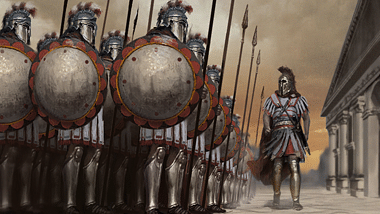
Brasidas (d. 422 BCE) was an enterprising and successful Spartan general during the early years of the second Peloponnesian War (431-404 BCE) between Athens and Sparta. His successes against the Athenians tilted the balance of the war back towards the Spartans after their disaster at Pylos (425 BCE). Brasidas encouraged a number of revolts against Athens and detached a number of cities, including the important city of Amphipolis, from the Athenian Empire. At the Battle of Amphipolis in 422 BCE he defeated an Athenian army led by Cleon; however, both generals died in the fighting. He was also responsible for Thucydides ' change of career from general to historian.
THE EARLY PELOPONNESIAN WAR
Nothing is known of the early life of Brasidas, son of Tellis. He first drew attention in Thucydides' account of the Peloponnesian War for his successful relief of the town of Methone against an Athenian assault in 431 BCE. An Athenian fleet of 100 ships, supported by 50 more from Corcyra ( Corfu ), was sailing around the Peloponnese to ravage the territory of Sparta and its allies. Arriving at Methone, they realised that it was not garrisoned and had a weak wall. As they were preparing to attack, Brasidas, who was in charge of a small force defending the district, managed to break through the Athenian army with only 100 hoplites. The Athenians could not afford a prolonged siege so this decisive action was enough to save Methone.According to Thucydides, Brasidas ''won the thanks of Sparta by his exploit, being thus the first officer who obtained this notice during the war'' ( The Peloponnesian War, 2.25). According to Xenophon ( Hellenica II.3.10), Brasidas was in the same year elected as one of Sparta's five annual magistrates (the ephors ), perhaps in recognition of his action at Methone.
By 429 BCE, the Spartan fleet had been bested in a succession of engagements by the Athenians. According to Thucydides, the Spartans were so lacking in naval knowledge that they could not understand that it was their lack of experience that was the problem. Consequently, they blamed their defeats on ''misconduct somewhere'' ( The Peloponnesian War, 2.85) and sent Brasidas, along with two other commissioners, to advise the Spartan admiral. After a reorganization of the fleet, the Peloponnesians won a small naval engagement at Naupactus. The victory was short-lived, however, as a single fleeing Athenian ship suddenly turned around and sunk its pursuer, causing a number of the Peloponnesian ships to run aground in panic. The rest of the Athenian fleet then sailed out to pursue the Peloponnesians, capturing six of their vessels and recapturing most of the ships they had lost in the earlier engagement.
BRASIDAS GAINED FURTHER RECOGNITION FOR AN AUDACIOUS ASSAULT ON THE ATHENIAN POSITIONS AT PYLOS IN 425 BCE.
We next hear of Brasidas in 427 BCE, when he was sent out to advise the Spartan admiral Alcidas. A civil war had broken out in Corcyra, and the Spartans took 50 ships to aid the pro-Peloponnesian oligarchic party against the pro-Athenian popular party. The oligarchs were defeated before their arrival and the Corcyraean fleet of 60 ships, supported by twelve Athenian ships, attacked the Peloponnesians. Thanks to Corcyraean in-fighting and disorganization, the Peloponnesians won a small victory; however, they then returned to the Peloponnese upon the approach of Athenian reinforcements, leaving the oligarchic party in Corcyra to be massacred by their opponents.
Brasidas gained further recognition for an audacious assault on the Athenian positions at Pylos in 425 BCE. As the Spartans attacked the Athenian positions by ship, some of the commanders were wary of running aground. According to Thucydides, Brasidas encouraged the attackers to sacrifice their ships. He forced his own ship ashore and was ''endeavoring to land when he was beaten back by the Athenians and after receiving many wounds fainted away'' ( The Peloponnesian War, 4.12).
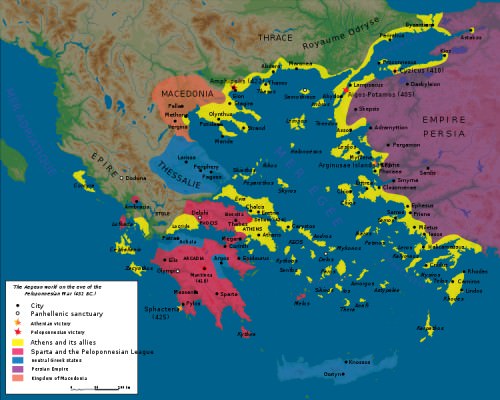
Peloponnesian War
In 424 BCE, the Athenians hatched a plot to conquer Megara using sympathizers inside the walls. Megara is located on a crucial strategic position on the isthmus between Athens and the Peloponnese. During the first Peloponnesian War (460-445 BCE), Megara had initially sided with Athens and control of Megara had prevented Peloponnesian armies from ravaging Attica or aiding their Theban allies. If Megara again fell into Athenian hands, it would have been a significant strategic victory for Athens. Fortunately for Sparta, Brasidas happened to be in the vicinity raising an army for a planned campaign in northern Greece. Showing none of the hesitation for which Spartans were famous, Brasidas sent a request for reinforcements to Thebes and supplemented his own forces with men from local poleis. The Theban reinforcements managed to surprise and defeat the Athenian light-armed troops around Megara, but a cavalry skirmish between the Thebans and Athenians ended in a stalemate. Brasidas drew up his army, which now numbered 6,000 hoplites and 600 cavalry, for battle on the plain. The Athenians, numbering only 4,600 hoplites, as well as light-armed troops and cavalry, decided against battle and withdrew. The Megarians, who had been waiting to see who would win the battle before declaring for either side, now opened their gates to Brasidas and executed those who were suspected of working with the Athenians.
CAMPAIGNS IN NORTHERN GREECE
Later in 424 BCE, Brasidas marched his new army to northern Greece. The region was an important source of Athenian raw materials, as well as a key stopping point for Athenian trade to the east. It was hoped that Athenian attacks on the Peloponnese could be diverted by attacking valuable Athenian possessions. Perdiccas, the king of Macedon, was wary of Athenian expansionism in the region, and a number of Chalcidian cities requested support so that they could defect from the Athenian Empire. Even with such promises of local support, the Spartan state was unwilling to risk the lives of Spartan citizens on such a long-range and high-risk campaign, so his army of 1,700 hoplites consisted of 1,000 mercenaries and 700 public slaves ( helots) who had been promised their freedom.
In Thucydides' account, Brasidas was not only a highly competent general, but he was also a successful orator. In a speech to the people of Acanthus, who were debating whether or not to join the Spartans, Brasidas persuasively argued that the only Spartan goal was the freedom of Greece and that the Spartans would respect the freedom of Acanthus. For anybody unconvinced by his eloquent rhetoric, he added that refusal to join him would result in the destruction of their vines and crops (Thucydides, The Peloponnesian War, 4.85-4.87).
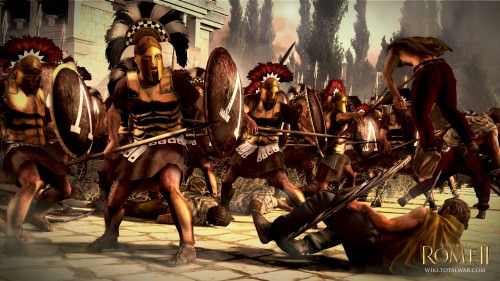
Spartan Warriors
In the winter following (424-423 BCE), Brasidas besieged Amphipolis. Hearing that an Athenian force led by Thucydides was on its way, Brasidas offered the inhabitants particularly good terms, which they accepted before the Athenian relief force arrived. Thucydides did manage to arrive at Eion before Brasidas, which he reinforced and defended from an attack. At this point, Brasidas requested reinforcements from Sparta, but his request was denied because the Spartans were hoping to arrange a truce in which they could recover the Spartan prisoners captured on Pylos. Even so, Brasidas managed to capture Torone in a surprise attack before a one-year armistice was agreed between Athens and Sparta in the following spring. During this truce of 423 BCE, Scione and Mende revolted from Athens and Brasidas supported them, breaking the terms of the agreement. He then joined Perdiccas in a campaign against the Lyncestians, during which the Macedonians abandoned the Spartans, leading to the dissolution of their alliance. Perdiccas then allied with the Athenians, making it difficult for any future Spartan reinforcements to reach Brasidas by land.
In 422 BCE, the Athenian demagogue Cleon was sent to defeat Brasidas. He initially enjoyed some success, managing to retake Torone before Brasidas could send support. Cleon and Brasidas met in battle at Amphipolis. Cleon had advanced from Eion to view Amphipolis with only a part of his force, not expecting Brasidas to come out to meet him. As Cleon was returning to Eion, Brasidas' forces emerged from Amphipolis and caught the Athenians in a state of disorder. The Athenian left fled immediately, but Brasidas was wounded in the pursuit and died shortly after he had heard of his victory. Cleon was killed as he fled, although the right flank which he commanded stood their ground until they were overcome by the missiles of Brasidas' peltasts and cavalry.
According to Thucydides, the people of Amphipolis built a tomb for Brasidas next to the agora, called him the founder of their city and ''ever afterwards sacrifice to him as a hero and have given to him the honor of games and annual offerings'' ( The Peloponnesian War, 5.11).
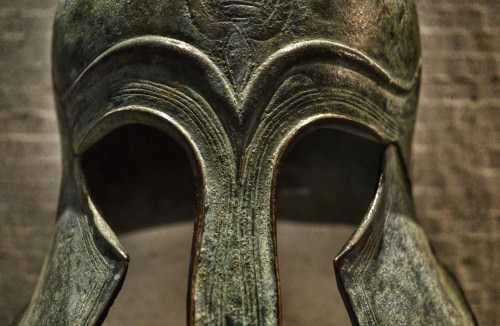
Corinthian Helmet (Detail)
REPERCUSSIONS OF HIS CAMPAIGNS
According to Thucydides, his 'just and moderate conduct' persuaded many cities to revolt; and his example later convinced other cities to request Spartan generals: he ''showed himself so good a man at all points as to leave behind him the conviction that the rest were like him'' ( The Peloponnesian War, 4.81). His campaigns in northern Greece resulted in a permanent reduction in Athenian influence in the region; and the loss of Amphipolis was taken particularly hard by the Athenians. Athens laid claim to Amphipolis for decades afterwards, and its eventual absorption into the Macedonian Kingdom in 357 BCE was a critical factor in Athenian animosity towards Philip. In the short term, Brasidas' victories counterbalanced Athenian successes against Sparta in other theatres. This helped Nicias to convince the Athenian assembly that peace with Sparta would be in their best interests. In addition, Brasidas and Cleon were ''the two principal opponents of peace on either side'' (Thucydides, The Peloponnesian War, 5.16), so their deaths helped make possible the Peace of Nicias in 421 BCE.
LEGACY
Despite the importance of Brasidas' military exploits, perhaps his most important legacy was the damage he did to the military reputation of the historian Thucydides. Thucydides was blamed when the relief force he led was too late to save Amphipolis.This failure destroyed Thucydides' public career and led to his exile from Athens - giving him plenty of time to write his unsurpassed history of the Peloponnesian War. If Thucydides was bitter about Brasidas' destruction of his career, his depiction of Brasidas in his history as a charismatic, energetic and inspiring figure did not show it. The glowing reputation of Brasidas was also used by Plutarch to demonstrate the stoical toughness of Spartan women. According to Plutarch, when messengers visited Brasidas' mother to tell her about the heroic death of her son, she informed them that ''Brasidas was a brave man, but Sparta has many better men than he'' ( Life of Lycurgus, 25).
Brundisium › Origins
Definition and Origins
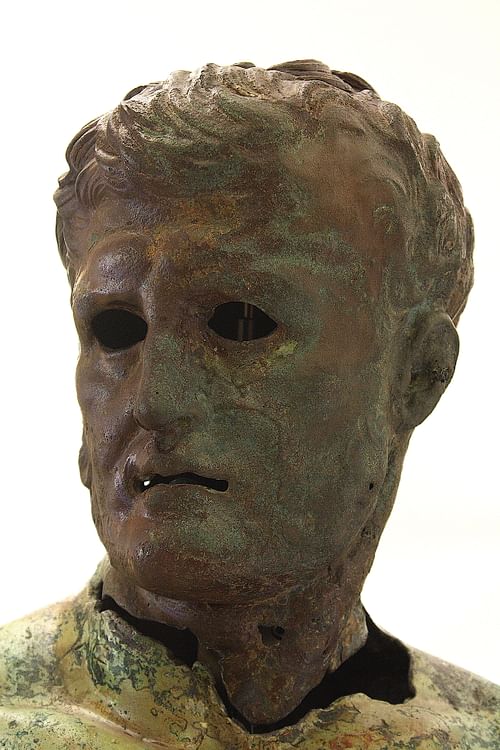
Brundisium (modern Brindisi), located on the Adriatic coast of southern Italy, was a Messapian and then Roman town of great strategic importance throughout antiquity. Although architectural remains are sparse, the city has several claims to fame.Brundisium is the end of the road for the Appian Way, was a traditional launching point for armies and travellers to the East, and played a pivotal role in both the Punic wars and Roman civil wars. Amongst its more impressive artefacts are many examples of Hellenistic and Roman bronze statuary which have been rescued from the town's harbour.
EARLY SETTLEMENT
The area of Brindisi was inhabited in Palaeolithic times some 12,000 years ago and the site of Torre Testa just 7 km to the north was the most important settlement in the region at that time. Thousands of stone tools and other artefacts have been discovered which belonged to the hunter-gatherers of the period. A continued presence in the Neolithic period and Bronze Age is attested by additional finds.
MESSAPIAN & GREEK TOWN
Located at the very bottom of the Italian peninsula, in local mythology Brundisium was first settled by either Diomedes, a hero of the Trojan War, or Phalanthus, the Spartan who was also credited with founding nearby Tarentum (modern Taranto). Yet other sources suggest Brundisium was founded by settlers from Crete. Certainly, a Greek influence, if not actually full colonization, is indicated in the cemetery at Tor Pisani. Little is known today regarding the town when it was inhabited by the Messapians, one of the tribes who lived in the 'heel' of Italy which constitutes modern Apulia. Their name for the town was Brentesion which may derive from the Messapian brentos, meaning 'dear's head', which describes the form of the harbour with its two distinctive promontories.
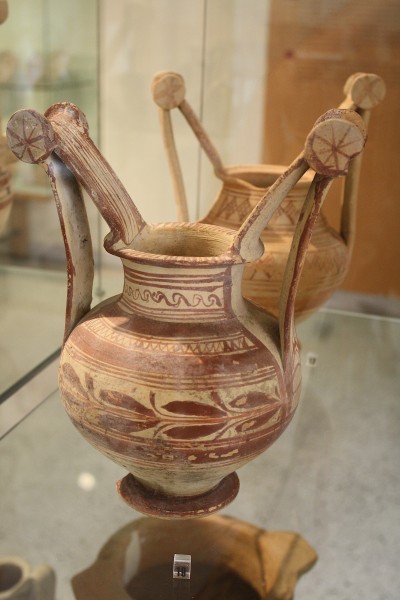
Two-handled Vase, Brundisium
The best surviving examples of Messapian culture are ceramics. In particular, the high-handled amphorae known as trozella are unique to the region and have geometrical and plant motif decorative designs. There is evidence of a long and bitter rivalry with Tarentum (modern Taranto), the Spartan colony some 75 kilometres to the west on Italy's southern coast. Brundusium minted its own coinage and formed an alliance with Thurii c. 440 BCE, another Greek colony to the west built on the site of old Sybaris.
ROMAN BRUNDISIUM
Brundisium started to take on a greater regional significance only from the 3rd century BCE onwards when Rome began to expand throughout the Italian peninsula. The Romans conquered the city in 266 BCE and a colony was formally established at Brundisium in 247 or 244 BCE. The city was then fortified in order to ensure the Romans kept hold of the excellent double harbour they had acquired. Around the same time the great Roman road the Via Appia (Appian Way) was extended to reach the city, connecting it with Rome itself and bringing its total paved length to 569 km or 385 Roman miles. Brundisium consequently became the main point of departure for anyone travelling to Greece and the East and usurped Tarentum's position as the most important port in the south. Today a 19.2 m tall single marble column stands near the waterfront which was traditionally thought to mark the spot where the road finally ends. In fact, inscriptions reveal that the column once belonged to a building with a religious or commemorative function connected to the sea.

End of the Appian Way Column Marker
During the First Punic War (264-241 BCE) the Carthaginian general Hamilcar Barca had attacked several Roman coastal cities in search of booty for his mercenaries and one of them was Brundisium in 247 BCE. These skirmishes, though, were largely a minor distraction from the main battlefront in Sicily. The city became more directly embroiled in the Second Punic War (218-201 BCE) when Hannibal invaded Italy and encamped in the southern corner of the peninsula. The Carthaginian general desperately needed a port through which he could receive reinforcements and supplies from Africa but the Romans successfully blockaded the harbours of the southern coast.
IN THE CIVIL WAR OF THE 1ST CENTURY BCE BRUNDISIUM WOULD, ONCE AGAIN, FIND ITSELF CENTRE STAGE IN THE THEATRE OF A BLOODY & BRUTAL WAR.
Sulla gave Brundusium an exemption from the portoria, the tax duty imposed on the import and export of goods at ports, and the town was given municipium status around 89 BCE which granted its citizens Roman citizenship. However, the city's fortunes would soon suffer a dramatic downturn during the violent final stages of the Roman Republic. In the civil war of the 1st century BCE Brundisium would, once again, find itself centre stage in the theatre of a bloody and brutal war. Julius Caesarcaptured the city in 49 BCE so that he could prevent his great rival Pompey from fleeing Italy. Then it was attacked again in 40 BCE, this time by Mark Antony. The city's handy location at the foot of Italy was proving something of a liability for the local residents. Brundisium was also the site of the accord, known as the Treaty of Brundisium, between Antony and Octavian to carve up the Roman empire between themselves. When Octavian won the war and became Emperor Augustus, a triumphal arch was set up in the city in his honour.
Yet another historical event linked to the city is the death of Virgil there in 19 BCE shortly after the writer returned from a trip to Greece. The city would continue to exist as a minor Roman town in the imperial period with the slave trade, fishing and shipbuilding providing plenty of employment and wealth for some as evidenced in the large villas of the period. A Christian community was founded by Saint Leucius of Alexandria in the second half of the 2nd century CE.
Unfortunately, the continual inhabitation of the site and constant re-use of ancient building materials has obscured its development in later times and left few standing remains. Excavations have revealed traces of all the usual features one would expect to find in a Roman town: a forum, market square, Roman baths, aqueducts, amphitheatre, necropolis and regular town plan. There was also an armamentarium or arsenal and several warehouses, both indicative of Brundisium's primary function as a gateway to Roman Italy for goods and troops.
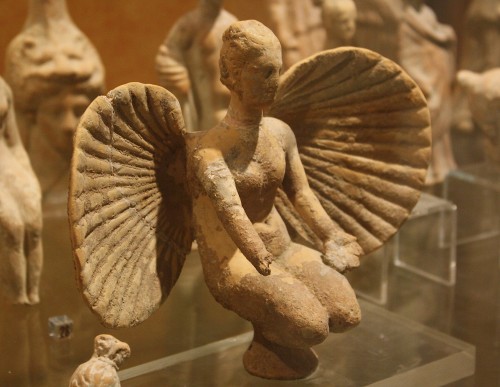
Terracotta Aphrodite, Brundisium
ARTEFACTS
While little remains of the ancient buildings of Brundisium, the city, and especially its harbour, has provided some outstanding examples of Greek and Roman art for posterity. Amongst these survivors are many bronze statues. Unfortunately, most are incomplete but some of them remain sufficiently intact to still instil awe at the skills of ancient metalworkers. A notable piece is the head and torso of a figure known as the Hellenistic Prince which dates to the 2nd or 1st century BCE. Another fine head has been identified as a Greek philosopher, possibly Antisthenes, and dates to the 4th century BCE. Besides many examples of trozella already mentioned, the town's archaeological museum possesses a fine collection of Greek pottery and terracotta figurines including a charming depiction of a crouched Aphrodite emerging from her shell.
Etruscan Clothing › Origins
Ancient Civilizations
The clothing of the ancient Etruscans, a civilization which flourished in central Italy between the 8th and 3rd century BCE, can be seen in many media of their art including wall paintings, bronze sculpture, stone relief carvings, and painted figures on terracotta funerary urns, as well as occasional descriptions by ancient foreign writers. The history and study of the Etruscan civilization have suffered in many areas due to the lack of firsthand texts and their ultimate cultural assimilation into the Roman world, but clothing is one subject where the Etruscans have an advantage over most ancient peoples. Clothing is perishable and even when it does survive, its original colouring does not, but with the Etruscans, we are fortunate in having the miraculously preserved wall paintings of their tombs which provide us with a unique opportunity to glimpse in glorious technicolour the flamboyant world of Etruscan fashion.
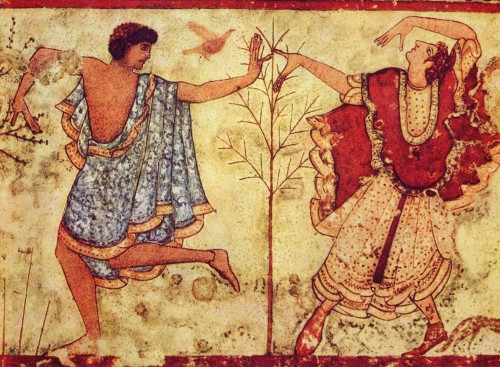
Dancers, Tomb of the Triclinium, Tarquinia
ORIGINS & DEVELOPMENT
Weaving was an important industry in most ancient cultures, and the Etruscans were no different. Finds of bronze tools such as loom weights, spools and spindles are evidence that the craft went back to the Villanovan culture, a precursor to the mature Etruscans, during the Iron Age in central Italy (1100-750 BCE). Wool weaving was first done in the private home on a small scale but not necessarily only by women as deposits of paraphernalia in male tombs suggests. As agriculture developed and natural resources such as metals were better exploited, communities prospered and a manufacturing class developed which could devote itself to the production of better quality daily goods. Clothing was amongst these, and the Etruscans became particularly noted in antiquity for their production of linen used for books and clothing. Wool, more easily dyed and heavier, was used for outer garments while inner ones used plain linen. Animal hides and, much more rarely, cotton, might also have been used for clothing.
The influence of Ionia and the Near East on Etruscan culture was also seen in clothing, especially in pointed footwear, soft conical hats, and generally highly decorative patterns. Then, as contact with Greece and Magna Graecia increased via trade, so too did the influence on fashion. Long dresses secured at the shoulder by a brooch, light shawls, a long, simple white cloak ( himation ) with a red or black border, and a short-sleeved tunic ( chiton ) made from linen are all seen in Etruscan tombpaintings, especially at coastal sites where the contact with the Greek world was more frequent.
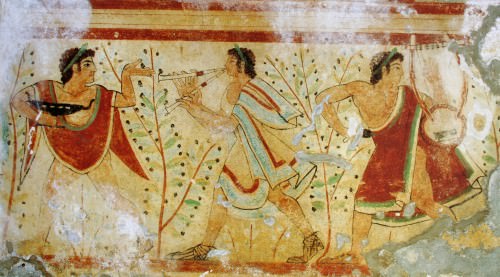
Musicians Wall-painting, Tarquinia
The most striking feature of Etruscan clothing, both for men and women, is the wide range of colours and cuts used. One must be cautious and remember that the costumes of musicians, dancers, and even diners in wall paintings may have been depicted wearing their ceremonial finery, and this does not necessarily reflect everyday clothing for themselves or people in general. Still, there is no doubt that the clothes for Etruria 's wealthy citizens (whose tombs were the only ones to be painted) and their slaves were bold in colour, design, and variety, reflecting both the more varied climate of central Italy compared to other parts of the Mediterranean and a more flamboyant taste than seen in contemporary cultures or what we know of them.Such was the contrast with the more austere Greek and Roman taste in fashion that Posidonius, the Greek scholar, famously noted that the extravagant clothing of Etruscan entertainers was "more beautiful than is fitting for slaves" (Heurgon, 172).
THE MOST STRIKING FEATURE OF ETRUSCAN CLOTHING, BOTH FOR MEN & WOMEN, IS THE WIDE RANGE OF COLOURS & CUTS USED.
WOMEN'S CLOTHES
Bright colours abound with cloaks, bodices, and short jackets in red, royal blue, pale green, orange, yellow, and sometimes with bold horizontal stripes, vertical stripes, or polka dots. Dresses are sleeveless, short-sleeved, and long-sleeved with varying hem lengths, sometimes with an arch cut over the feet. Outer garments are often sumptuously embroidered with decorative motifs such as the lady in the Tomb of Francesca Giustiniani at Tarquinia whose orange-pink cloak is speckled with dots and stars. The dark red cloak of a lady in the Tomb of the Lionesses at Tarquinia (530-520 BCE) is decorated with embroidered flowers and has blue additions in front which hang like wide straps. Dancers in tombs at Chiusi have the same type of hanging lapels or revers in front. The hems of garments sometimes have tasselled or otherwise decorative fringes.
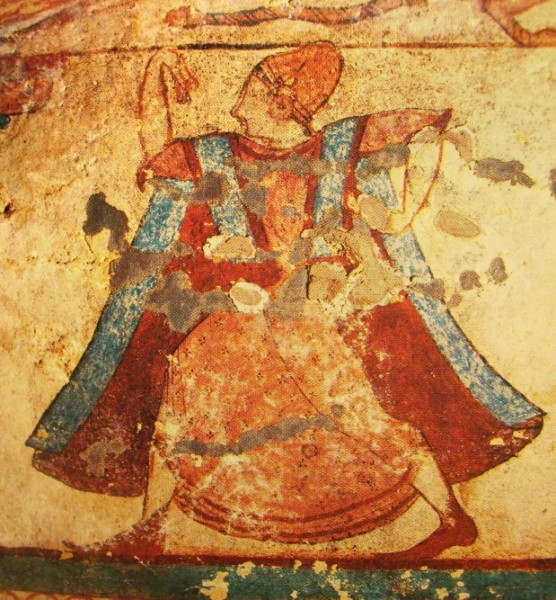
Dancer, Tomb of the Lionesses, Tarquinia
Clothes are extravagantly cut and in stark contrast to the austere perpendicular lines of Greek clothing. Sleeves billow at the cuffs, as do trousers with flared bell-bottoms, a silhouette which is only accentuated by tight belted waistlines. Cloaks and wrap-around mantles with a low round neckline appear on both men and women and seem to be made of a thick material (as they would have to be to protect in cool winter weather) with heavy folds. They have a different colour lining from the exterior and often have coloured borders on both sides.
MEN'S CLOTHES
We have seen that women's clothes could be colourful with embroidered decoration, and men's clothes were sometimes no different. The magistrate or auspicium (reader of omens) known as Vel Saties from the Francois Tomb at Vulci (late 4th century BCE) is an example. He wears a striking dark blue embroidered cloak which has several nude male figures who are dancing while carrying shields in a slightly garish concoction worthy of a 21st-century CE Dolce & Gabbana creation. Another commonly depicted item is the short tunic or jerkin ( tunica ), worn with a belt. Finally, priests have a costume of their own: a sheepskin worn inside out over a simple sleeved tunic which hangs down to the boots. The costume is completed with a soft conical-peaked hat held in place by chin straps.

Vel Saties & Arnza, Francois Tomb
One of the longer-lasting fashions the Etruscans gave to antiquity was the toga, to them the trebenna. Worn over the left shoulder and leaving the right shoulder bare, it is seen in mid-6th-century BCE terracotta plaques from Cerveteri where a king wears a purple one. Other figures wear one, this time decorated with a red border, in the Tomb of the Augurs at Tarquinia (c. 520 BCE). The Romans would adopt the toga, albeit making it a little longer and varying its folds, as a badge of distinction for the patrician class, keeping the red or purple border (derived from the Tyrian purple dye) and reserving the all-purple robe for emperors and those basking in the glory of a Roman triumph. The Etruscans, however, seemed to have been a little more democratic with their clothing, for the toga, usually all white, is seen in tomb paintings worn by musicians in, for example, Tarquinia.
FOOTWEAR
A feature of the Etruscans is that they wore shoes, seemingly more frequently than their Greek counterparts. Pointed shoes, for both men and women, are especially common in art; again an influence from Ionia and the Near East. Those in Tarquinia's Tomb of the Augurs and Tomb of the Baron (c. 510 BCE) look like a cross between boots and slippers and are green, red, or burgundy in colour. They widen at the front, then finish in a slightly raised point at the toes. Reaching up to the calf, they finish in a turnover split at the front. Similar types depicted on terracotta plaques have a long tongue and horizontal straps to fasten the boots around the heel and another tie that passes through an eyehole at the top of the boot.
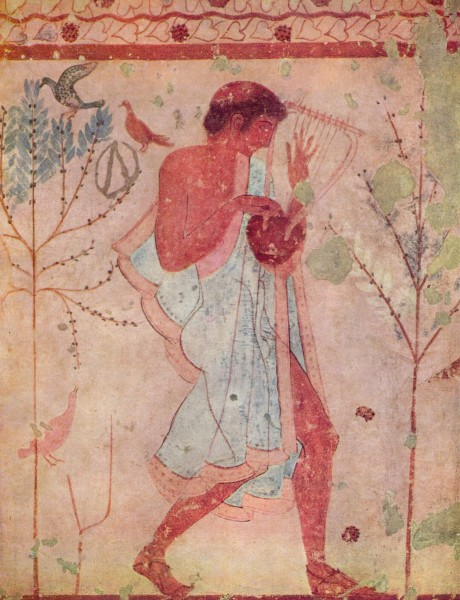
Musician, Tomb of the Triclinium, Tarquinia
Less complicated shoes are worn by slaves which cover only the feet and the most typical is the simple sandal held on the foot by cross-straps. One can imagine sandals were worn by everyone in warmer weather as suggested by a pair appearing in the Tomb of the Stucco Reliefs at Cerveteri (last quarter 4th century BCE). These sandals have semicircular bands and a cord for the toes and appear at the end of the bed of the aristocratic occupant of the tomb. The Greeks called Etruscan sandals Tyrrhenica sandalia, and they are described as having high wooden soles with rather decadent gilded straps. Finds at Cerveteri and Bisenzio of surviving soles have metal studs, no doubt to make them last longer. In contrast, for wet weather, shoes and feet were sometimes protected by overshoes made from very thin sheet bronze.
See other Related Content for Ancient History ››
LICENSE
Article based on information obtained from these sources:with permission from the Website Ancient History Encyclopedia
Content is available under License Creative Commons: Attribution-NonCommercial-ShareAlike 3.0 Unported. CC-BY-NC-SA License